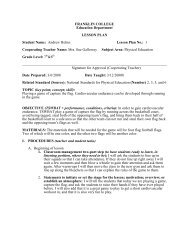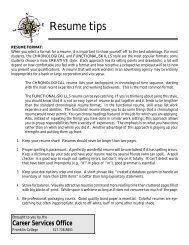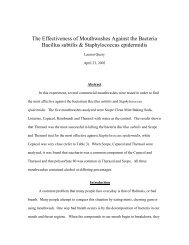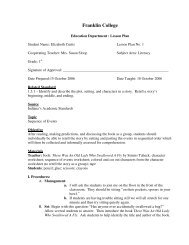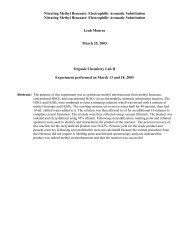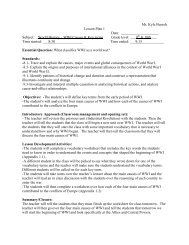Melissa Bockhold Heather Coddington - Franklin College
Melissa Bockhold Heather Coddington - Franklin College
Melissa Bockhold Heather Coddington - Franklin College
Create successful ePaper yourself
Turn your PDF publications into a flip-book with our unique Google optimized e-Paper software.
X. SILVER LAKE PARTNERS INTERVIEW<br />
Mr. Alan Austin, Managing Director and Chief Operating Officer<br />
Silver Lake Partners<br />
2725 Sand Hill Road, Suite 150<br />
Menlo Park, CA 94025<br />
Ph: 1-650-233-8149<br />
The following questions and responses collected through a phone interview with Silver<br />
Lake Partners Managing Director and Chief Operating Officer, Alan Austin at 4:00 PM<br />
Wednesday March 15, 2006.<br />
Question: How do you value a company when you are considering investing in<br />
them?<br />
Answer: The fundamental metric of valuing a company is their cash flow. You<br />
must look at EBITDA and Capital Expenditures. You want to start with<br />
Capital and take out the depreciation, interest expense, taxes and<br />
amortization.<br />
Taxes are not a factor because more than likely, they will be at a reduced<br />
rate after the restructuring. Interest expense is not relevant because you<br />
will be borrowing more than in the past. Depreciation is not factored in<br />
because these are your expenses of the past. What you spent in the past<br />
does not matter, from here on, it’s about future expenses. Finally,<br />
amortization is not relevant because it is non-cash.<br />
Other factors considered in valuing a company includes how fast they are<br />
growing and whether they are in an attractive market.<br />
Question: Why was Seagate given a $2 billion price tag?<br />
Answer: We used the same analysis as I explained in the last question. We looked<br />
at their EBITA and tried to see what the company could do to improve<br />
them and move forward. For example, they can cut their operating<br />
expenses.<br />
Question: How do you determine the target capital structure of a company you plan<br />
to invest in? Seagate?<br />
Answer: In 1999, the amount of debt available to companies was 100%. However,<br />
we had to look at what the company’s capacity to service the debt they<br />
undertook. There has to be a comfortable margin in case of a bump in the<br />
road. You also cannot leverage too much because then the company does<br />
not have the resources to implement the changes or take on investments to<br />
further their success.<br />
In Seagate’s example, they had no net debt at the time of the leverage.<br />
Net debt is defined as when your debt exceeds your short term assets.<br />
44




